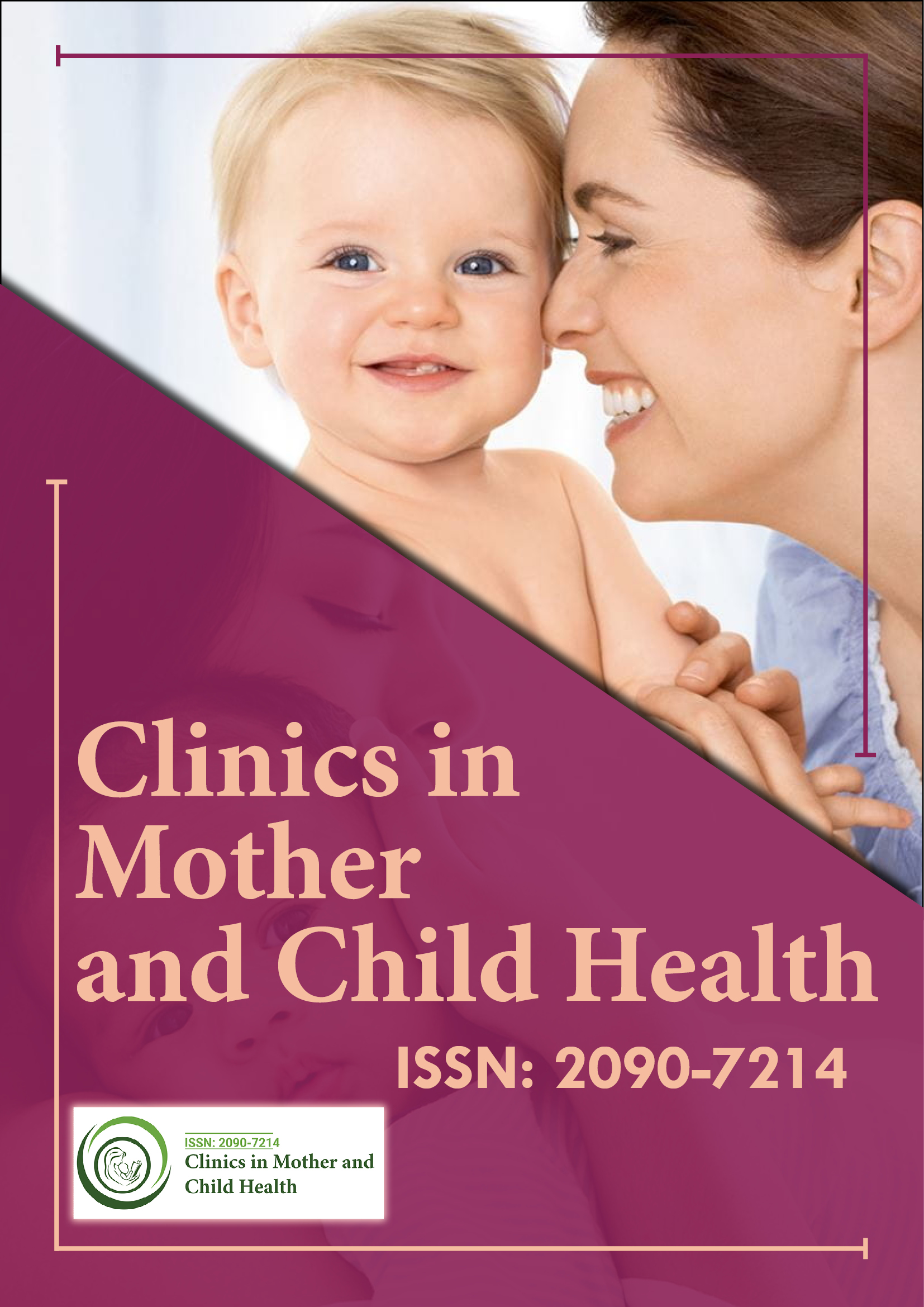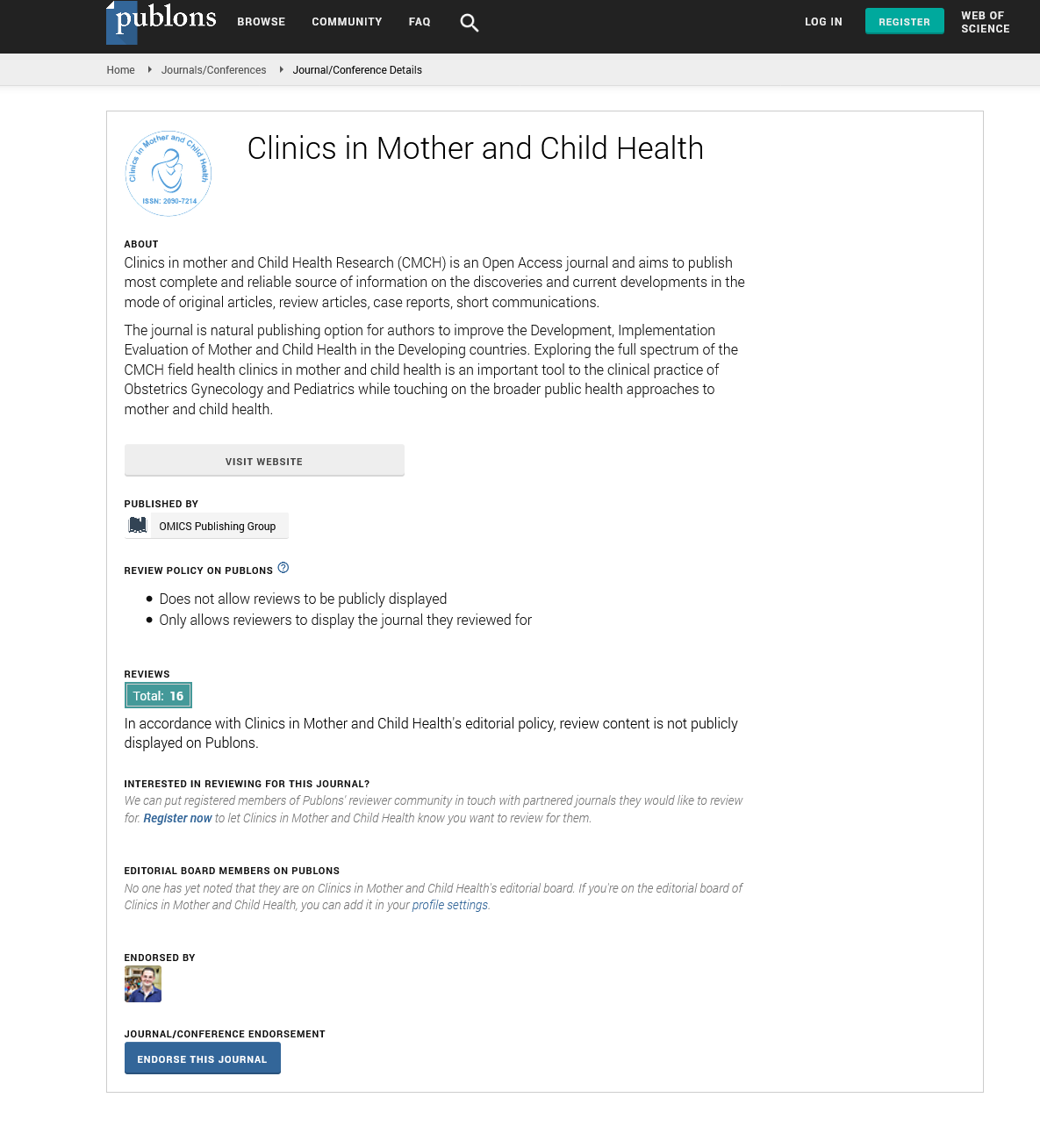Indexed In
- Genamics JournalSeek
- RefSeek
- Hamdard University
- EBSCO A-Z
- Publons
- Geneva Foundation for Medical Education and Research
- Euro Pub
- Google Scholar
Useful Links
Share This Page
Journal Flyer

Open Access Journals
- Agri and Aquaculture
- Biochemistry
- Bioinformatics & Systems Biology
- Business & Management
- Chemistry
- Clinical Sciences
- Engineering
- Food & Nutrition
- General Science
- Genetics & Molecular Biology
- Immunology & Microbiology
- Medical Sciences
- Neuroscience & Psychology
- Nursing & Health Care
- Pharmaceutical Sciences
Opinion Article - (2025) Volume 22, Issue 7
Clinic Functioning and Child Wellbeing in Rural Eastern India
Sangeeta Roy*Received: 01-Jul-2025, Manuscript No. CMCH-25-30097; Editor assigned: 03-Jul-2025, Pre QC No. CMCH-25-30097; Reviewed: 16-Jul-2025, QC No. CMCH-25-30097; Revised: 21-Jul-2025, Manuscript No. CMCH-25-30097; Published: 28-Jul-2025, DOI: 10.35248/2090-7214.25.22.535
Description
In various districts across eastern India, maternal and child health clinics play a critical role in serving hundreds of rural villages, where issues such as poverty, caste-related barriers and poor road infrastructure limit access to timely healthcare. These clinics provide key prenatal services like chromium screening, blood testing, tetanus vaccinations and counselling on nutrition and rest during pregnancy. After childbirth, newborns are weighed, vaccinated, observed for signs of illness, while mothers receive postnatal care and advice on infant feeding practices. Many villages are located far from these clinics and travel becomes especially hazardous during the monsoon season when roads are washed away or become impassable. These challenges often lead to delays in seeking care, with many women postponing their first antenatal check-up until well into the second trimester or later. This delay reduces the chances of early identification and treatment of conditions such as anemia, gestational hypertension, or maternal malnutrition. In more severe cases, women arrive at clinics only during the final stages of labor due to the lack of transport options, significantly raising risks for both mother and child.
Staffing at these rural clinics is often minimal. Auxiliary nurse midwives typically manage all responsibilities, including antenatal care, childbirth assistance, immunizations and growth monitoring often all in one day. Trained specialists such as obstetricians and pediatricians are rarely available at peripheral facilities. In many cases, clinic staff are overburdened, juggling fixed-site duties alongside community outreach activities. Medical equipment is basic and limited: ultrasounds are not commonly available, laboratory diagnostics are minimal and maintaining the vaccine cold chain remains a challenge in areas with unreliable electricity. Cultural and traditional norms also impact healthcare usage. Some women feel uncomfortable with clinical examinations, especially when male staff are present, limiting their willingness to seek care. In several communities, it is still widely believed that childbirth should happen at home under the care of traditional birth attendants. Furthermore, practices such as early introduction of supplemental feeding instead of exclusive breastfeeding are common, particularly when the mother returns to work or travels to her parental home after delivery.
Despite these challenges, outreach initiatives have made noticeable progress. Mobile health clinics visit clusters of villages on a rotating basis, conducting immunization drives, growth assessments and community education on maternal and child health. Community health volunteers also play a vital role by educating women about warning signs during pregnancy such as persistent fever or reduced fetal movement which helps encourage early intervention. Government-backed financial incentives also reduce access barriers. Maternity benefit schemes, free essential medicines, waived delivery charges and subsidized transportation help ensure that more women attend clinics without worrying about costs. Flexible service hours especially during busy agricultural or festival seasons have also encouraged greater participation. Allowing women to choose appointment times based on their household responsibilities makes it easier for them to seek care. In addition, the use of digital tools is steadily expanding. In some districts, pilot programs using simple electronic health records are underway to track prenatal visits, vaccination dates and referral needs. Sending appointment reminders via text message in regional languages has proven to significantly reduce missed appointments.
Clinic cleanliness and hygiene also influence attendance. Facilities with clean water, functioning toilets, safe delivery rooms and sheltered waiting areas are far more likely to attract mothers. When women feel physically comfortable and see that the facility is hygienic, they are more willing to bring their children for regular care. Staff behavior also matters kindness, clear communication and respectful treatment go a long way in building community trust and encouraging repeat visits. Supplementation with iron, folic acid and vitamins during pregnancy has shown to result in improved birth weights. Clinics that routinely monitor maternal weight gain, assess hemoglobin levels and provide dietary counselling using locally available foods tend to report fewer low birth weight deliveries. Postnatal support, especially through home visits, is crucial in identifying and managing common issues such as neonatal jaundice, feeding problems, or maternal mental health concerns like postpartum depression. When local governments prioritize the regular supply of medicines, vaccines and trained staff, overall health outcomes improve. Maternal and infant mortality rates decrease and child nutrition levels begin to rise. Engaging village councils and women themselves in decisions about clinic timings and services further boosts attendance. Even small, consistent enhancements in service delivery can bring about meaningful, long-lasting improvements in maternal and child health in rural regions of India.
Citation: Roy S (2025). Clinic Functioning and Child Wellbeing in Rural Eastern India. 22:535.
Copyright: © 2025 Roy S. This is an open-access article distributed under the terms of the Creative Commons Attribution License, which permits unrestricted use, distribution and reproduction in any medium, provided the original author and source are credited.

